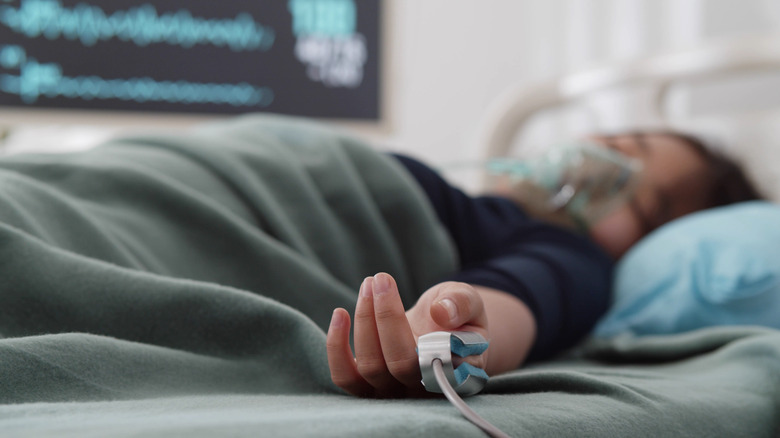Amazing Stories Of People Who Survived Rabies Without A Vaccine
According to the Centers for Disease Control and Prevention (CDC), rabies is a zoonotic viral infection most often spread by dogs and wild animals. And in 99% of all cases, when an unvaccinated human catches it, it's fatal, the CDC elsewhere writes. Clearly, though, a 99% fatality rate is not 100% — meaning there are some rare cases when unvaccinated individuals seem to survive rabies either with inadequate vaccination or with minimal medical intervention. In the U.S., alone, there have only been three known such instances, ABC News reported in 2011.
Experts disagree as to how some people survive a typically deadly infection like rabies, ranging from random luck on the part of the individual to a characteristic of the disease similar to how it presents in animals (rabies does not always kill animals). The application of the Milwaukee protocol — an experimental and risky rabies treatment method — may have also played a part.
Regardless of how these lucky individuals lived after rabies, vaccines are still the best line of defense. Still, here's a closer look at just a few of the amazing stories of how rabies-infected people beat the odds and survived (via Scientific American).
Jeanna Giese was bitten by a bat
In 2004, 15-year-old Wisconsin teenager Jeanna Giese was bitten by a bat she touched outside her church. At first, her parents didn't think much of it and simply cleaned the wound, which didn't seem serious. A few weeks later, though, Giese was sickened with a number of classic rabies symptoms, including double vision and vomiting. Since it had been some time since Giese was bitten, it was too late for post-bite rabies antivirals, and her prognosis seemed bleak.
The effects of rabies on the brain and spinal cord can take weeks to manifest — sometimes longer, according to the Canadian Center for Occupational Health and Safety (CCOHS). As The New York Times reported the year Giese was infected, when she was taken to the Children's Hospital of Wisconsin in Wauwatosa, near Milwaukee, she was only intermittently conscious and critically ill. As a last resort, the Milwaukee protocol — an unproven treatment — was called upon to try and save her life.
In the experimental treatment developed by Doctor Rodney Willoughby, a coma is induced in potentially critically-ill rabies patients. According to Willoughby's theory, areas of the brain typically targeted by the rabies virus go dormant while the patient's immune system continues to fight, supported by antiviral treatments. In Giese's case, at least, the protocol worked. It had been tried before, but she was the first survivor. "In all honesty, we were probably just pretty lucky," Willoughby said, admitting more clinical trials and research were needed.
An 8-year-old girl in California was scratched by a stray cat
Seven years after Jeanna Giese, in 2011, an 8-year-old girl in California named Precious Reynolds contracted rabies from a minor cat scratch. Like Giese, Reynolds, who was unvaccinated, developed her symptoms too late for antiviral treatment, and by the time she entered UC Davis Children's Hospital, she had developed encephalitis, a kind of brain inflammation associated with rabies infection, ABC News reports.
Due to the uncertainty as to exactly when they were infected, neither Giese or Reynolds were given rabies immune globulin, which is typically administered along with post-infection antiviral treatments. Like Giese, Reynolds was also treated using the Milwaukee protocol, and she survived. Of this second Milwaukee protocol success, Dr. Greg Poland of the Mayo Clinic said (via ABC News), "This is indeed a very, very unusual course of events."
Dr. Rodney Willoughby added (via ABC News), "Whether this is just a natural tendency for an occasional survivor or whether our therapy is providing added value is up for discussion. Some people may be able to survive naturally." Speaking with the Austin-American Statesman, Willoughby said, "We made something up and it worked. Getting it to work again — that's been much harder. Either we're doing something right, or we're just lucky."
A 17-year-old Texas girl survived rabies on her own
Unlike both Jeanna Giese and Precious Reynolds, who recovered from rabies using the Milwaukee protocol, the third known person in the U.S. to recover from rabies with inadequate vaccination seemed to survive the infection on her own. (The patient was a runaway at the time she sought medical treatment, and her name was kept private in the press, the Austin-American Statesman reported in 2012). In 2009, the teenage girl sought medical treatment and was found to be infected with rabies, the CDC writes. She had come in contact with bats, but did not recall being bit.
Once she tested positive for rabies, she was given the first of five post-infection rabies vaccinations, but the cycle was discontinued for fear it might complicate her immune response. Inexplicably, she still recovered. According to Dr. Charles Rupprecht of the CDC's rabies program, some humans may just survive rabies like some animals do. "Abortive rabies is not unusual in research animals — it happens spontaneously all the time," he said (via the Austin-American Statesman).
Though the Milwaukee protocol seemed to work in at least two cases, infected patients died in other circumstances, and more research is needed. Still, these examples of rabies recovery have spurred a fresh look at the infection. As Dr. Tom Sidwa head of the Texas Health Department rabies program told the Austin-American Statesman, before the 2009 case in Texas, in particular, "anything that suggested improvement, they said, 'That ain't rabies.' They can't say that anymore."



